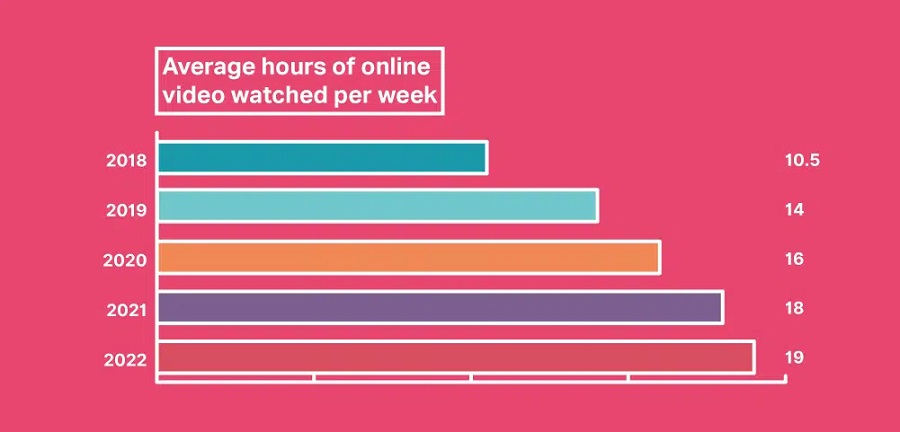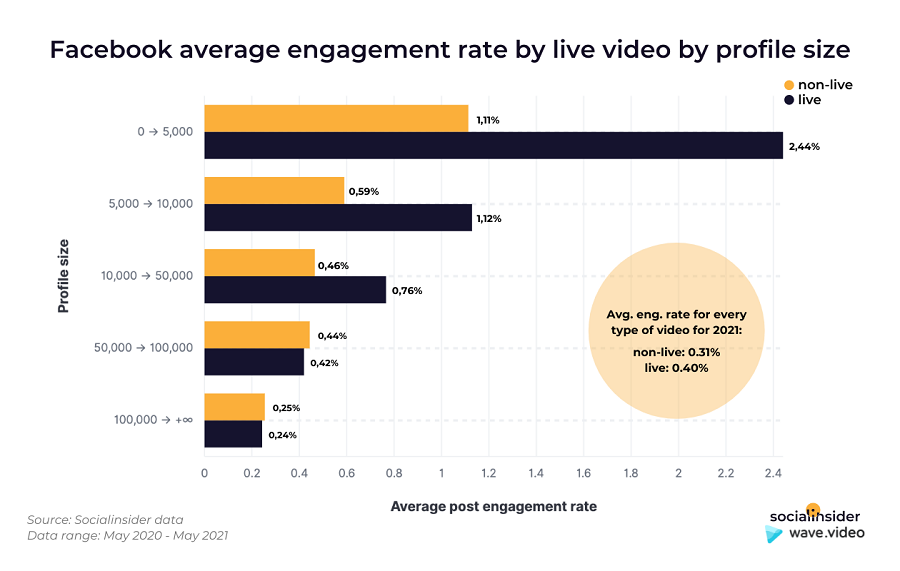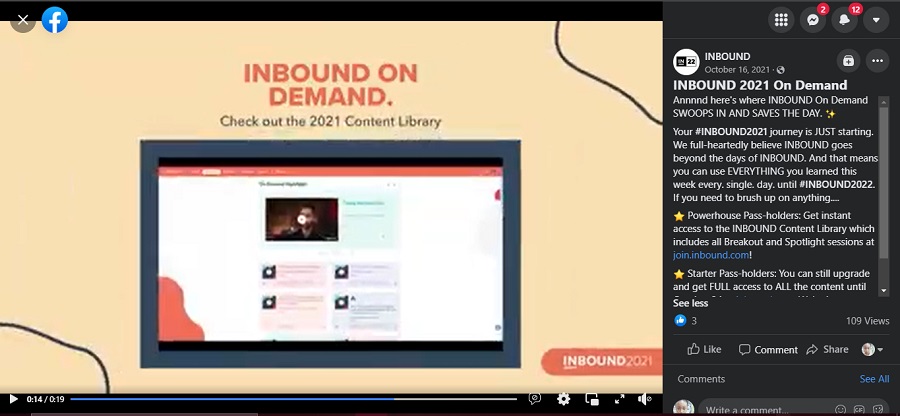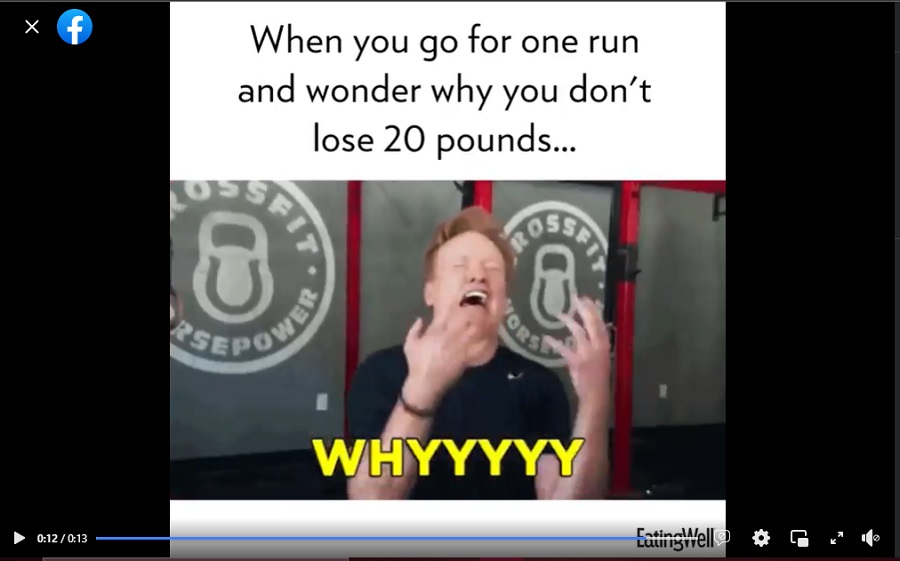Have you ever noticed a videographer present at a wedding, graduation, or other important events? Capturing a moment on video can be of a higher value than just a photo or written-out recap. Videos captivate viewers by showcasing the emotion and context behind the main message.

Luckily, your business’s videos can also edit out moments like this.
Using the Facebook video marketing platform is a great way to get messages out to your target audience. Facebook currently has almost 3 billion active users, making it a vital tool for small businesses to push sales via social media marketing in a more engaging way.
In this post, we’ll discuss:
- Why Facebook video marketing is important for your brand.
- How to use Facebook video marketing to help your business stand out.
- Real-life Facebook video marketing examples you can source inspiration from.
And… Action!
Why Facebook video marketing is important for your business
Times have changed, and so have the leading marketing trends and plans. Why Facebook video marketing? Short answer: People are watching more videos online. The number of online videos that people watch has almost doubled since 2018.

More marketers also feel more optimistic about the return on investment (ROI) offered by video marketing since it continues to influence leads, traffic, sales, and audience engagement.
How to implement a Facebook video marketing strategy
Here are some ways for small businesses to use Facebook video marketing to their advantage:
1. Include a strong CTA
An efficient Facebook video marketing campaign should always use a call-to-action (CTA) button leading to the product landing page.
Adding CTAs to the Facebook video is easy. Once you’ve uploaded the video, the ‘Add a Call-to-Action’ tab option will appear right away. This option lets you choose from either; ‘Learn More,’ ‘Shop Now,’ or ‘Book Now.’ These options will redirect your viewer to your website, but if they choose ‘Watch More,’ it will show them more of the videos on your page.
For instance, here’s a video by Pasquale Sciarappa, a local chef, advertising a recipe and products.

This video CTA link allows the user to subscribe if interested in the content and view the products mentioned in the video. This local chef gets to do what he enjoys most: engage his viewers and promote his products.
2. Go live
Aside from posting pre-recorded videos, Facebook Live is another way business owners can explore video content.
A Facebook video study on nearly 4 million video posts discovered that live videos have longer retention power than pre-recorded videos. Pre-recorded videos make up 81.13% of the published Facebook videos, while live videos take up only 18.87%. It’s a relatively low number but a 55% increase compared to 2020.
Many small businesses think it’s much safer to produce and then edit the video, adding or deleting certain things from the recording, but the numbers prove otherwise. Live videos are getting double the engagement, as shown on this graph.

In reality, people don’t want over-polished content. Authenticity is the best strategy here. You can retain some level of authenticity in pre-recorded videos, but the brand gains a more personal touch with live videos and real people.
Additionally, live videos that last more than one hour generate more engagement. If you’re new, you can first test out Facebook Live by using the “Only me” option to ensure that this live stream doesn’t show up on people’s News Feed before you figure your way around.
Here are some video ideas for a compelling Facebook Live video:
- Product launches: This is an effective video marketing strategy that’s commonly underutilized. Product launches create a buzz around upcoming products. Once the live Facebook video is done, create short one-minute videos from it and post them on other platforms before the actual product’s launch.
- Q&A sessions: You can also do a quick Q&A session with your target audience that’s value-packed and informative. This format works well with an established user base that enthusiastically engages with you.
- Tutorials and How-to’s: Facebook video marketing through live videos can include an online business teaching its viewers how to do some things. This is one way to engage, educate, and entertain your audience. Polished pre-recorded tutorials often skip the challenges people in real-time might be facing. But live sessions give a more realistic picture of things and real potential problems that might arise. This allows you to address that with solutions and results.
- Invite experts: Another great Facebook live video idea is sharing insights and tips straight from industry leaders and experts on your session.
To prepare for an interview, make a list of questions that you’ll ask and brief your guest in advance. This helps you both prepare and know how the conversation will go. A list of questions also helps you avoid going off-topic. Additionally, make the talk more interactive by taking questions from live viewers.
3. Upload videos directly to Facebook
YouTube is a leading video-sharing platform, but it’s still not a good idea to upload a marketing video on it, then share it on your Facebook page using a link. Native videos directly uploaded to Facebook tend to have more customer engagement.
There are different types of Facebook videos that exist, which include:
- Linked videos
- Native videos
- Facebook live videos
- Facebook stories
- Facebook video ads
Facebook native videos get 168% more interactions and 477% more shares compared to YouTube videos posted on Facebook.
To back this research, the brand Agorapulse ran a Facebook native videos test throughout the month of January on their Facebook pages to validate these findings. The results for the month, on average, were a Facebook native video reach of 883 and a YouTube video reach of 473.
After posting, you can easily resize and optimize these videos on other social media platforms. These platforms may include Instagram, Tiktok, and YouTube. This point brings us to the following strategy: content repurposing.
Related: Having trouble with Facebook? Find out how to contact Facebook support.
4. Repurpose your successful content
Your content doesn’t have to be useful just once. You can repurpose it to achieve the following goals:
- Reach new audiences
- Reinforce your message
- Improve your organic visibility
- Save time since you won’t have to think about new content
- Reduce the costs of video production
However, repurposing video content is more than just cutting and pasting your old videos.
Here are a few ways to efficiently repurpose a marketing video-to-video content:
- Using testimonials as content for your product pages or social media pages: You can gather snippets of customer testimonial videos, compile them into a testimonial “supercut” video, then publish the video towards the end of the year as a “thank you” to your loyal customers.
- Turn video content into blog posts: You can do blog posts based on your Facebook Live video and then embed your Facebook video in it. Additionally, other content creators could use your video if it’s interesting or relevant for their blog posts–you do need to ensure they credit you for it.
- Podcasts: You can also use snippets from your Facebook video in your podcast series.
- Success stories: Alternatively, you can turn internal data and insights from the posts into case studies.
Here’s a good example from HubSpot, which repurposed videos from its annual INBOUND event into blog content for its blog:

Like sending recurring emails in marketing, repurposing is a smart way to save time and resources if you already have good video content on your Facebook.
5. Create short and engaging videos
Short videos have a special place in video marketing and marketing strategy. The Facebook algorithm prioritizes those that are at least three minutes long. Most viewers leave in the first 30 seconds or less if the video is not engaging enough, so you’ll need to nail it hard in the first couple of seconds.
This ad by Eating Well now has over 1 million views. The value of this level of viewership alone is priceless.

The video is just 13 seconds long, funny, and captures your attention until the end while still giving the message. Short videos like these are easier to do if you can find a way to resonate with your viewers. You can use humor to reel in your viewers and make your content more accessible.
Speaking of accessibility, adding closed captioning will ensure that your audience can understand your videos, even if they’re watching in a public place or with the audio turned off. It will also benefit users with hearing difficulties for a more inclusive marketing strategy.
You can also play around with aspect ratios. While most Facebook videos use landscape orientation, you can also shoot them in portrait. This method will help your video appear larger and grab more attention by taking up more space. In addition, vertical videos are the default setting in TikTok and Instagram stories, making them easier to repurpose later on.
To help improve your Facebook video marketing strategy, you’ll need to do your user research by checking for insights on the Page Insights tab. You can analyze previous posts to see the average engagement rate.
6. Tap into Facebook video ads
Facebook Ad campaigns that include videos can help you reach your engagement goals.
With more than half a billion viewers watching 100 million hours of Facebook video content every day, brands can get lost in all this shuffle easily. However, Facebook video ad campaigns help the algorithm to prioritize your content above organic posts. This strategy makes your business stand out and ensures that you appear in front of your audience.
Boosted or sponsored video posts to be displayed on the Facebook timelines of users who match your laid out customer persona, whether or not they follow your Facebook page. Running a sponsored video campaign is one way to reach users who might be interested in your product or brand that may not have found you otherwise.
7. Include all the necessary information
Since Facebook videos are relatively short, you need to find a way to express your main points in the first few seconds. By giving viewers a good idea of the rest of the video, you can convince them to watch it through the end. However, you need to define your social media goals to determine the information you’ll include in your Facebook video.
For example, if your goal is to sell a product, the video should include the product’s features, price, and availability. You may also want to announce a discount to boost sales instantly. However, not all of your content should be aimed toward making a sale. A known best practice is to have around 80% of your posts be informational, educational, or entertaining, while the other 20% should go to the promotion of the brand.
Here’s a recent example by a brand called All Day I Dream About Food that uses Facebook videos to advertise its recipes.

From this example, we see the use of great short post teases and an interesting starter. The first frame already piques the viewer’s interest. Everything else teases and informs the viewer and directs them to click on the link in the caption for the full recipe.
Here are some ways to always help you ensure that you put the relevant information in your Facebook video content:
- For more impact, always go with a few words, especially if the material is new to your viewers.
- Great titles, headlines, and captions will spark the viewer’s interest and positively impact the SEO, increasing your video’s potential reach.
- Never include text above the bottom 20% of the video frame to ensure nothing gets awkwardly cut off.
- Strike a balance between graphics and text in each frame, but avoid text if you can say it with a picture.
- The best times to post video content on social media are 10 a.m. on Tuesday, Wednesday, and Thursday.
Including the relevant information is one way to keep your viewers hooked. The demographics and insights should help you determine what your audience is most interested in.
Cut! That’s a wrap: Your Facebook video marketing is ready for success
With the different inbound and outbound prospect-lead conversion strategies, Facebook video marketing ranks as one of the most popular and effective channels for businesses of all shapes and sizes. Uploading and promoting your marketing videos on Facebook gives your brand the potential to reach millions of prospective customers worldwide.
Following the tips I’ve discussed today will help reach your customers and generate global exposure, leads, and conversions to your brand. Best of luck!
To recap, here are our seven Facebook video marketing tips:
- Include a strong CTA
- Try a Facebook live video
- Upload videos directly to Facebook
- Repurpose top-performing videos
- Create videos that vary in length
- Try Facebook video ad campaigns
- Be sure your Facebook videos include all the need-to-know info
About the author
 David Campbell is a digital marketing specialist at Ramp Ventures. He helps manage the content marketing team at Right Inbox. When he’s not working, he enjoys traveling and trying to learn Spanish.
David Campbell is a digital marketing specialist at Ramp Ventures. He helps manage the content marketing team at Right Inbox. When he’s not working, he enjoys traveling and trying to learn Spanish.






